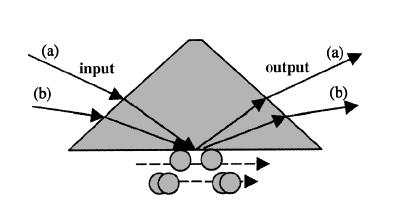Overview:
There has been considerable recent
interest in the development of methods which extend the spatial
resolution of optical microscopy beyond the classical diffraction limit.
Approaches such as Near-field Scanning Optical Microscopy (NSOM) and
Photon Scanning Tunneling Microscopy (PSTM),
have been used to obtain
There has also been significant
recent activity in the development of 3-D near-field imaging. One such
method is a destructive method called nanotomography, in which a sample
is successively eroded and then imaged layer by layer with a scanning
probe microscope. A nondestructive approach based upon the solution to
the linearized near-field inverse scattering problem for 3-D
inhomogeneous media was recently present by Carney and Schotland. For
this method, the input data for the image reconstruction algorithm
requires both the amplitude and phase of the scattered field. Measuring
the optical phase is notoriously difficult.
We have seen in Optical
Power-Extinction Tomography (OPET) that it
is possible to circumvent the phase problem by making use of two-beam
power extinction measurements. The basic principle at work in OPET with
homogeneous waves also applies when evanescent waves illuminate the
sample. Evanescent waves offer several advantages. First because
evanescent waves decay exponentially with distance away from the plane
in which they are generated, they work very well to localize objects at
or just below the surface of the sample. Second, evanescent waves are
super-oscillatory, i.e. they vary in space more rapidly than
homogeneous waves, and so they provide a means to probe the
high-frequency components of the object normally not accessible with
homogeneous waves. In this manner NOPET potentially provides
super-resolved images.
Current efforts on this project
include an extension of the optical theorem to electromagnetic waves in
a half-space geometry and the development of the OPET experiment.

FIG. 1. Illustrating the experiment.
Beams (a) and (b) generate evanescent waves which are incident on the scatter.
The extinguished power is then measured at the output via difference measurements
with and without the scatterer present.
|
References:
- P S Carney, V Markel and J C Schotland, "Near-Field
Tomography without Phase Retrieval," Phys. Rev. Lett. 86, 5874-5877
(2001). PDF
- P S Carney "The optical cross-section theorem with incident
fields containing evanescent components," J. Mod. Opt. 46, 891-899
(1999). PDF
- P S Carney, E Wolf, and G S Agarwal, "Diffraction tomography
using power extinction measurements," J. Opt. Soc. Am. A 16, 2643-2648
(1999). PDF
- P S Carney, E Wolf, and G S Agarwal, "Statistical
generalizations of the optical cross-section theorem with application to
inverse scattering," J. Opt. Soc. Am. A 14, 3366-3371 (1997). PDF
This project is being funded by an Airforce MURI grant and an NSF Career Award.
See theFunding page for more details
|
